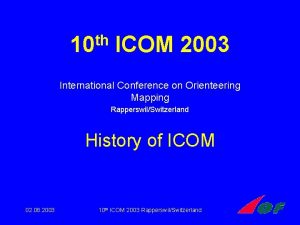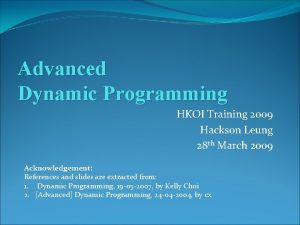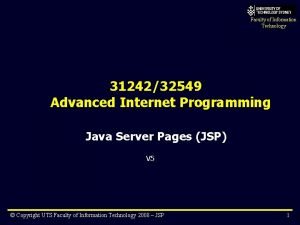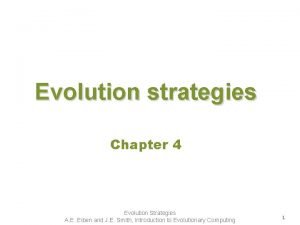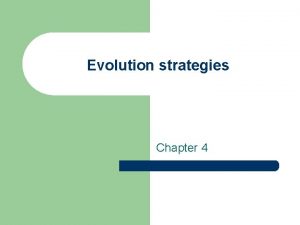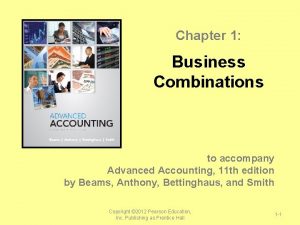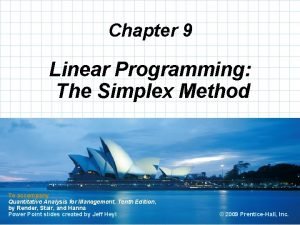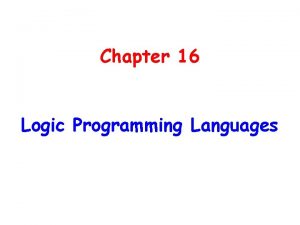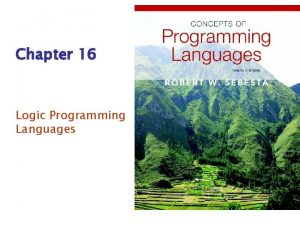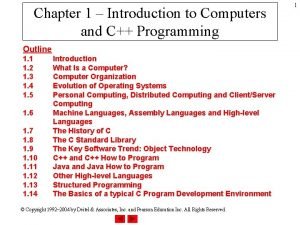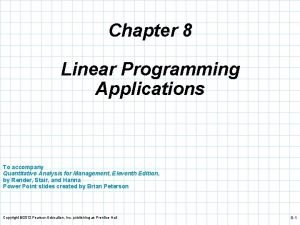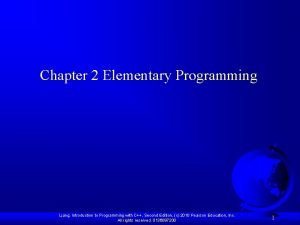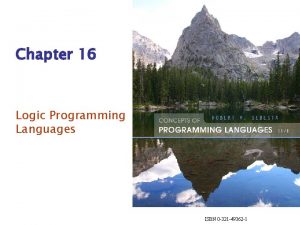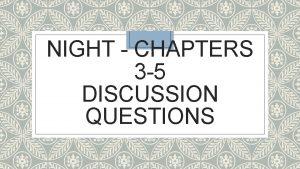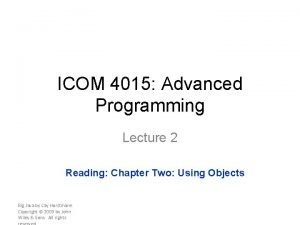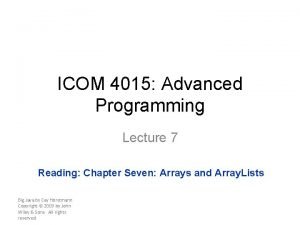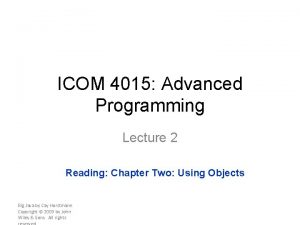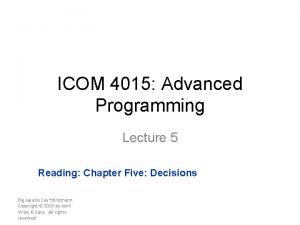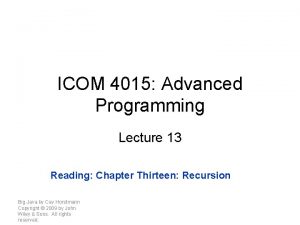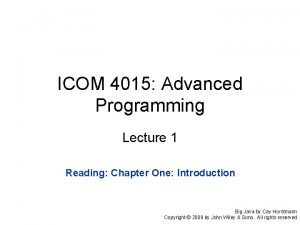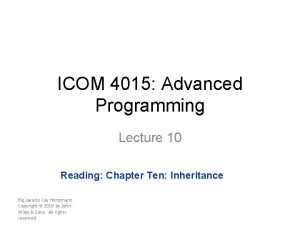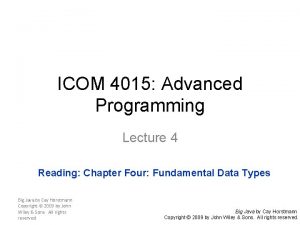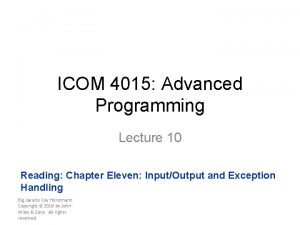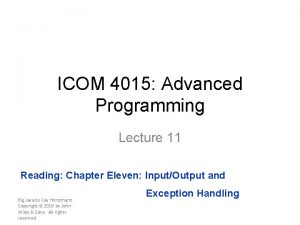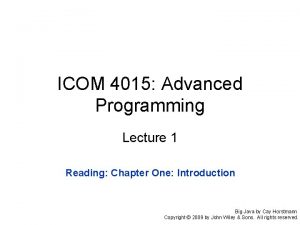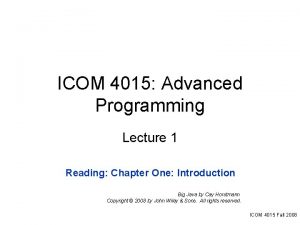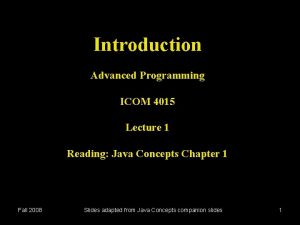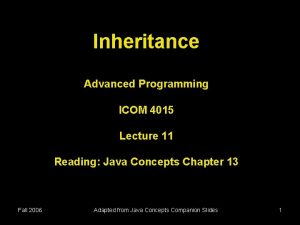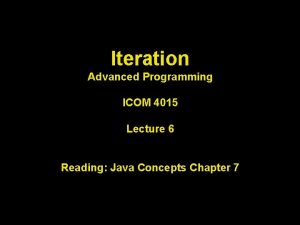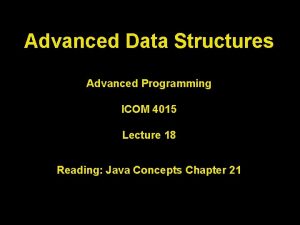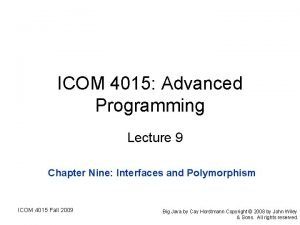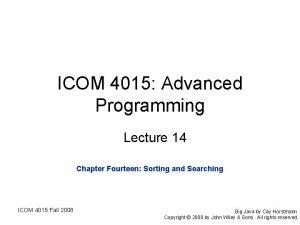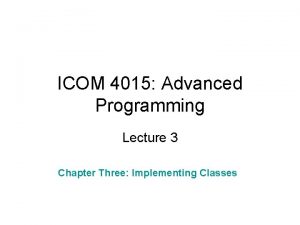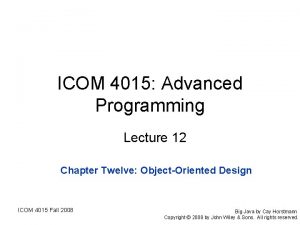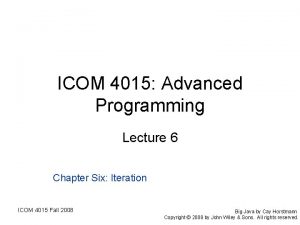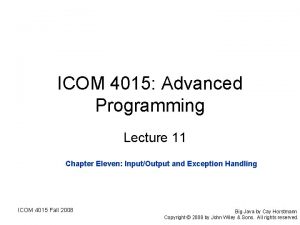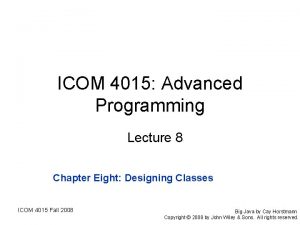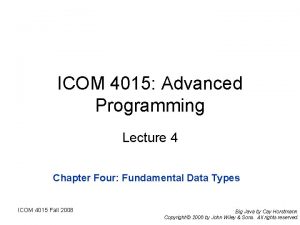ICOM 4015 Advanced Programming Lecture 10 Reading Chapter




















































- Slides: 52

ICOM 4015: Advanced Programming Lecture 10 Reading: Chapter Eleven: Input/Output and Exception Handling Big Java by Cay Horstmann Copyright © 2009 by John Wiley & Sons. All rights reserved.

Chapter Goals • To be able to read and write text files • To learn how to throw exceptions • To be able to design your own exception classes • To understand the difference between checked and unchecked exceptions • To know when and where to catch an exception Big Java by Cay Horstmann Copyright © 2009 by John Wiley & Sons. All rights reserved.

Reading Text Files • Simplest way to read text: Use Scanner class • To read from a disk file, construct a File. Reader • Then, use the File. Reader to construct a Scanner object File. Reader reader = new File. Reader("input. txt"); Scanner in = new Scanner(reader); • Use the Scanner methods to read data from file • next, next. Line, next. Int, and next. Double Big Java by Cay Horstmann Copyright © 2009 by John Wiley & Sons. All rights reserved.

Writing Text Files • To write to a file, construct a Print. Writer object: Print. Writer out = new Print. Writer("output. txt"); • If file already exists, it is emptied before the new data are written into it • If file doesn’t exist, an empty file is created • Use print and println to write into a Print. Writer: out. println(29. 95); out. println(new Rectangle(5, 10, 15, 25)); out. println("Hello, World!"); • You must close a file when you are done processing it: out. close(); Otherwise, not all of the output may be written to the disk file Big Java by Cay Horstmann Copyright © 2009 by John Wiley & Sons. All rights reserved.

File. Not. Found. Exception • When the input or output file doesn’t exist, a File. Not. Found. Exception can occur • To handle the exception, label the main method like this: public static void main(String[] args) throws File. Not. Found. Exception Big Java by Cay Horstmann Copyright © 2009 by John Wiley & Sons. All rights reserved.

A Sample Program • Reads all lines of a file and sends them to the output file, preceded by line numbers • Sample input file: Mary had a little lamb Whose fleece was white as snow. And everywhere that Mary went, The lamb was sure to go! • Program produces the output file: /* 1 */ Mary had a little lamb /* 2 */ Whose fleece was white as snow. /* 3 */ And everywhere that Mary went, /* 4 */ The lamb was sure to go! • Program can be used for numbering Java source files Big Java by Cay Horstmann Copyright © 2009 by John Wiley & Sons. All rights reserved.

ch 11/lines/Line. Numberer. java import java. io. File; import java. io. File. Not. Found. Exception; import java. io. Print. Writer; import java. util. Scanner; /** This program applies line numbers to a file. */ public class Line. Numberer { public static void main(String[] args) throws File. Not. Found. Exception { // Prompt for the input and output file names Scanner console = new Scanner(System. in); System. out. print("Input file: "); String input. File. Name = console. next(); System. out. print("Output file: "); String output. File. Name = console. next(); Continued Big Java by Cay Horstmann Copyright © 2009 by John Wiley & Sons. All rights reserved.

ch 11/fileio/Line. Numberer. java (cont. ) // Construct the Scanner and Print. Writer objects for reading and writing File input. File = new File(input. File. Name); Scanner in = new Scanner(input. File); Print. Writer out = new Print. Writer(output. File. Name); int line. Number = 1; // Read the input and write the output while (in. has. Next. Line()) { String line = in. next. Line(); out. println("/* " + line. Number + " */ " + line); line. Number++; } in. close(); out. close(); } } Big Java by Cay Horstmann Copyright © 2009 by John Wiley & Sons. All rights reserved.

File Dialog Boxes Big Java by Cay Horstmann Copyright © 2009 by John Wiley & Sons. All rights reserved.

File Dialog Boxes JFile. Chooser chooser = new JFile. Chooser(); File. Reader in = null; if (chooser. show. Open. Dialog(null) == JFile. Chooser. APPROVE_OPTION) { File selected. File = chooser. get. Selected. File(); reader = new File. Reader(selected. File); . . . } Big Java by Cay Horstmann Copyright © 2009 by John Wiley & Sons. All rights reserved.

Reading Text Input: Reading Words • The next method reads a word at a time: while (in. has. Next()) { String input = in. next(); System. out. println(input); } • With our sample input, the output is: Mary had a little lamb … • A word is any sequence of characters that is not white space Big Java by Cay Horstmann Copyright © 2009 by John Wiley & Sons. All rights reserved.

Reading Text Input: Processing Lines • The next. Line method reads a line of input and consumes the newline character at the end of the line: String line = in. next. Line(); • Example: process a file with population data from the CIA Fact Book with lines like this: China 1330044605 India 1147995898 United States 303824646. . . • First read each input line into a string Big Java by Cay Horstmann Copyright © 2009 by John Wiley & Sons. All rights reserved.

Reading Text Input: Processing Lines • Then use the is. Digit and is. Whitespace methods to find out where the name ends and the number starts. E. g. locate the first digit: int i = 0; while (!Character. is. Digit(line. char. At(i))) { i++; } • Then extract the country name and population: String country. Name = line. substring(0, i); String population = line. substring(i); Big Java by Cay Horstmann Copyright © 2009 by John Wiley & Sons. All rights reserved.

Reading Text Input: Processing Lines • Use the trim method to remove spaces at the end of the country name: country. Name = country. Name. trim(); • To convert the population string to a number, first trim it, then call the Integer. parse. Int method: int population. Value = Integer. parse. Int(population. trim()); Big Java by Cay Horstmann Copyright © 2009 by John Wiley & Sons. All rights reserved.

Reading Text Input: Processing Lines • Occasionally easier to construct a new Scanner object to read the characters from a string: Scanner line. Scanner = new Scanner(line); • Then you can use line. Scanner like any other Scanner object, reading words and numbers: String country. Name = line. Scanner. next(); while (!line. Scanner. has. Next. Int()) { country. Name = country. Name + " " + line. Scanner. next(); } int population. Value = line. Scanner. next. Int(); Big Java by Cay Horstmann Copyright © 2009 by John Wiley & Sons. All rights reserved.

Reading Text Input: Reading Numbers • next. Int and next. Double methods consume white space and the next number: double value = in. next. Double(); • If there is no number in the input, then a Input. Mismatch. Exception occurs; e. g. • To avoid exceptions, use the has. Next. Double and has. Next. Int methods to screen the input: if (in. has. Next. Double()) { double value = in. next. Double(); . . . } Big Java by Cay Horstmann Copyright © 2009 by John Wiley & Sons. All rights reserved.

Reading Text Input: Reading Numbers • next. Int and next. Double methods do not consume the white space that follows a number • Example: file contains student IDs and names in this format: 1729 Harry Morgan 1730 Diana Lin . . . • Read the file with these instructions: while (in. has. Next. Int()) { int student. ID = in. next. Int(); String name = in. next. Line(); Process the student ID and name } Big Java by Cay Horstmann Copyright © 2009 by John Wiley & Sons. All rights reserved.

Reading Text Input: Reading Numbers • Initially, the input contains • After the first call to next. Int, the input contains • The call to next. Line reads an empty string! The remedy is to add a call to next. Line after reading the ID: int student. ID = in. next. Int(); in. next. Line(); // Consume the newline String name = in. next. Line(); Big Java by Cay Horstmann Copyright © 2009 by John Wiley & Sons. All rights reserved.

Reading Text Input: Reading Characters • To read one character at a time, set the delimiter pattern to the empty string: Scanner in = new Scanner(. . . ); in. use. Delimiter(""); • Now each call to next returns a string consisting of a single character • To process the characters: while (in. has. Next()) { char ch = in. next(). char. At(0); Process ch } Big Java by Cay Horstmann Copyright © 2009 by John Wiley & Sons. All rights reserved.

Throwing Exceptions • Throw an exception object to signal an exceptional condition • Example: Illegal. Argument. Exception: Illegal parameter value: Illegal. Argument. Exception exception = new Illegal. Argument. Exception("Amount exceeds balance"); throw exception; • No need to store exception object in a variable: throw new Illegal. Argument. Exception("Amount exceeds balance"); • When an exception is thrown, method terminates immediately • Execution continues with an exception handler Big Java by Cay Horstmann Copyright © 2009 by John Wiley & Sons. All rights reserved.

Example public class Bank. Account { public void withdraw(double amount) { if (amount > balance) { Illegal. Argument. Exception exception = new Illegal. Argument. Exception("Amount exceeds balance"); throw exception; } balance = balance - amount; } . . . } Big Java by Cay Horstmann Copyright © 2009 by John Wiley & Sons. All rights reserved.

Hierarchy of Exception Classes Big Java by Cay Horstmann Copyright © 2009 by John Wiley & Sons. All rights reserved.

Syntax 11. 1 Throwing an Exception Big Java by Cay Horstmann Copyright © 2009 by John Wiley & Sons. All rights reserved.

Checked and Unchecked Exceptions • Two types of exceptions: • Checked o The compiler checks that you don’t ignore them o Due to external circumstances that the programmer cannot prevent o Majority occur when dealing with input and output For example, IOException o • Unchecked o Extend the class Runtime. Exception or Error o They are the programmer’s fault o Examples of runtime exceptions: Number. Format. Exception Illegal. Argument. Exception Null. Pointer. Exception o Example of error: Out. Of. Memory. Error Big Java by Cay Horstmann Copyright © 2009 by John Wiley & Sons. All rights reserved.

Checked and Unchecked Exceptions • Categories aren’t perfect: • Scanner. next. Int throws unchecked Input. Mismatch. Exception • Programmer cannot prevent users from entering incorrect input • This choice makes the class easy to use for beginning programmers • Deal with checked exceptions principally when programming with files and streams • For example, use a Scanner to read a file: String filename =. . . ; File. Reader reader = new File. Reader(filename); Scanner in = new Scanner(reader); • But, File. Reader constructor can throw a File. Not. Found. E`xception Big Java by Cay Horstmann Copyright © 2009 by John Wiley & Sons. All rights reserved.

Checked and Unchecked Exceptions • Two choices: 1. Handle the exception 2. Tell compiler that you want method to be terminated when the exception occurs • Use throws specifier so method can throw a checked exception public void read(String filename) throws File. Not. Found. Exception { File. Reader reader = new File. Reader(filename); Scanner in = new Scanner(reader); . . . } • For multiple exceptions: public void read(String filename) 1. throws IOException, Class. Not. Found. Exception Continued Big Java by Cay Horstmann Copyright © 2009 by John Wiley & Sons. All rights reserved.

Checked and Unchecked Exceptions (cont. ) • Keep in mind inheritance hierarchy: If method can throw an IOException and File. Not. Found. Exception, only use IOException • Better to declare exception than to handle it incompetently Big Java by Cay Horstmann Copyright © 2009 by John Wiley & Sons. All rights reserved.

Catching Exceptions • Install an exception handler with try/catch statement • try block contains statements that may cause an exception • catch clause contains handler for an exception type Continued Big Java by Cay Horstmann Copyright © 2009 by John Wiley & Sons. All rights reserved.

Catching Exceptions • Example: try { String filename =. . . ; File. Reader reader = new File. Reader(filename); Scanner in = new Scanner(reader); String input = in. next(); int value = Integer. parse. Int(input); . . . } catch (IOException exception) { exception. print. Stack. Trace(); } catch (Number. Format. Exception exception) { System. out. println("Input was not a number"); Big Java by Cay Horstmann } Copyright © 2009 by John Wiley & Sons. All rights reserved.

Catching Exceptions • Statements in try block are executed • If no exceptions occur, catch clauses are skipped • If exception of matching type occurs, execution jumps to catch clause • If exception of another type occurs, it is thrown until it is caught by another try block • catch (IOException exception) block • exception contains reference to the exception object that was thrown • catch clause can analyze object to find out more details • exception. print. Stack. Trace(): Printout of chain of method calls that lead to exception Big Java by Cay Horstmann Copyright © 2009 by John Wiley & Sons. All rights reserved.

The finally Clause • Exception terminates current method • Danger: Can skip over essential code • Example: reader = new File. Reader(filename); Scanner in = new Scanner(reader); read. Data(in); reader. close(); // May never get here • Must execute reader. close() even if exception happens • Use finally clause for code that must be executed “no matter what” Big Java by Cay Horstmann Copyright © 2009 by John Wiley & Sons. All rights reserved.

The finally Clause File. Reader reader = new File. Reader(filename); try { Scanner in = new Scanner(reader); read. Data(in); } finally { reader. close(); // if an exception occurs, finally clause // is also executed before exception // is passed to its handler } Big Java by Cay Horstmann Copyright © 2009 by John Wiley & Sons. All rights reserved.

The finally Clause • Executed when try block is exited in any of three ways: 1. After last statement of try block 2. After last statement of catch clause, if this try block caught an exception 3. When an exception was thrown in try block and not caught • Recommendation: Don’t mix catch and finally clauses in same try block Big Java by Cay Horstmann Copyright © 2009 by John Wiley & Sons. All rights reserved.

Syntax 11. 4 finally Clause Big Java by Cay Horstmann Copyright © 2009 by John Wiley & Sons. All rights reserved.

Designing Your Own Exception Types • You can design your own exception types — subclasses of Exception or Runtime. Exception • if (amount > balance) { throw new Insufficient. Funds. Exception( "withdrawal of " + amount + " exceeds balance of " + balance); } • Make it an unchecked exception — programmer could have avoided it by calling get. Balance first • Extend Runtime. Exception or one of its subclasses • Supply two constructors 1. Default constructor 2. A constructor that accepts a message string describing reason for exception Big Java by Cay Horstmann Copyright © 2009 by John Wiley & Sons. All rights reserved.

Designing Your Own Exception Types public class Insufficient. Funds. Exception extends Runtime. Exception { public Insufficient. Funds. Exception() {} public Insufficient. Funds. Exception(String message) { super(message); } } Big Java by Cay Horstmann Copyright © 2009 by John Wiley & Sons. All rights reserved.

Case Study: A Complete Example • Program • Asks user for name of file • File expected to contain data values • First line of file contains total number of values • Remaining lines contain the data • Typical input file: 3 1. 45 -2. 1 0. 05 Big Java by Cay Horstmann Copyright © 2009 by John Wiley & Sons. All rights reserved.

Case Study: A Complete Example • What can go wrong? • File might not exist • File might have data in wrong format • Who can detect the faults? • File. Reader constructor will throw an exception when file does not exist • Methods that process input need to throw exception if they find error in data format • What exceptions can be thrown? • File. Not. Found. Exception can be thrown by File. Reader constructor • IOException can be thrown by close method of File. Reader • Bad. Data. Exception, a custom checked exception class Big Java by Cay Horstmann Copyright © 2009 by John Wiley & Sons. All rights reserved.

Case Study: A Complete Example • Who can remedy the faults that the exceptions report? • Only the main method of Data. Set. Tester program interacts with user • Catches exceptions • Prints appropriate error messages • Gives user another chance to enter a correct file Big Java by Cay Horstmann Copyright © 2009 by John Wiley & Sons. All rights reserved.

ch 11/data/Data. Analyzer. java import java. io. File. Not. Found. Exception; import java. io. IOException; import java. util. Scanner; /** This program reads a file containing numbers and analyzes its contents. If the file doesn' t exist or contains strings that are not numbers, an error message is displayed. */ public class Data. Analyzer { public static void main(String[] args) { Scanner in = new Scanner(System. in); Data. Set. Reader reader = new Data. Set. Reader(); boolean done = false; while (!done) { Continued Big Java by Cay Horstmann Copyright © 2009 by John Wiley & Sons. All rights reserved.

ch 11/data/Data. Analyzer. java (cont. ) try { System. out. println("Please enter the file name: "); String filename = in. next(); double[] data = reader. read. File(filename); double sum = 0; for (double d : data) sum = sum + d; System. out. println("The sum is " + sum); done = true; } catch (File. Not. Found. Exception exception) { System. out. println("File not found. "); } catch (Bad. Data. Exception exception) { System. out. println("Bad data: " + exception. get. Message()); } catch (IOException exception) { exception. print. Stack. Trace(); } } } } Big Java by Cay Horstmann Copyright © 2009 by John Wiley & Sons. All rights reserved.

The read. File Method of the Data. Set. Reader Class • Constructs Scanner object • Calls read. Data method • Completely unconcerned with any exceptions Big Java by Cay Horstmann Copyright © 2009 by John Wiley & Sons. All rights reserved.

The read. File Method of the Data. Set. Reader Class • If there is a problem with input file, it simply passes the exception to caller: public double[] read. File(String filename) throws IOException, Bad. Data. Exception // File. Not. Found. Exception is an IOException { File. Reader reader = new File. Reader(filename); try { Scanner in = new Scanner(reader); read. Data(in); } finally { reader. close(); } return data; Big Java by Cay Horstmann Copyright © 2009 by John Wiley & Sons. All rights reserved. }

The read. Data Method of the Data. Set. Reader Class • Reads the number of values • Constructs an array • Calls read. Value for each data value: private void read. Data(Scanner in) throws Bad. Data. Exception { if (!in. has. Next. Int()) throw new Bad. Data. Exception("Length expected"); int number. Of. Values = in. next. Int(); data = new double[number. Of. Values]; for (int i = 0; i < number. Of. Values; i++) read. Value(in, i); if (in. has. Next()) throw new Bad. Data. Exception("End of file expected"); } Big Java by Cay Horstmann Copyright © 2009 by John Wiley & Sons. All rights reserved.

The read. Data Method of the Data. Set. Reader Class • Checks for two potential errors 1. File might not start with an integer 2. File might have additional data after reading all values • Makes no attempt to catch any exceptions Big Java by Cay Horstmann Copyright © 2009 by John Wiley & Sons. All rights reserved.

The read. Value Method of the Data. Set. Reader Class private void read. Value(Scanner in, int i) throws Bad. Data. Exception { if (!in. has. Next. Double()) throw new Bad. Data. Exception("Data value expected"); data[i] = in. next. Double(); } Big Java by Cay Horstmann Copyright © 2009 by John Wiley & Sons. All rights reserved.

Scenario 1. Data. Set. Tester. main calls Data. Set. Reader. read. File 2. read. File calls read. Data 3. read. Data calls read. Value 4. read. Value doesn’t find expected value and throws Bad. Data. Exception 5. read. Value has no handler for exception and terminates 6. read. Data has no handler for exception and terminates 7. read. File has no handler for exception and terminates after executing finally clause 8. Data. Set. Tester. main has handler for Bad. Data. Exception; handler prints a message, and user is given another chance to enter file name Big Java by Cay Horstmann Copyright © 2009 by John Wiley & Sons. All rights reserved.

ch 11/data/Data. Set. Reader. java import java. io. File; import java. io. IOException; import java. util. Scanner; /** Reads a data set from a file. The file must have the format number. Of. Values value 1 value 2 . . . */ public class Data. Set. Reader { private double[] data; Continued Big Java by Cay Horstmann Copyright © 2009 by John Wiley & Sons. All rights reserved.

ch 11/data/Data. Set. Reader. java (cont. ) /** Reads a data set. @param filename the name of the file holding the data @return the data in the file */ public double[] read. File(String filename) throws IOException { File in. File = new File(filename); Scanner in = new Scanner(in. File); try { read. Data(in); return data; } finally { in. close(); } } Continued Big Java by Cay Horstmann Copyright © 2009 by John Wiley & Sons. All rights reserved.

ch 11/data/Data. Set. Reader. java (cont. ) /** Reads all data. @param in the scanner that scans the data */ private void read. Data(Scanner in) throws Bad. Data. Exception { if (!in. has. Next. Int()) throw new Bad. Data. Exception("Length expected"); int number. Of. Values = in. next. Int(); data = new double[number. Of. Values]; for (int i = 0; i < number. Of. Values; i++) read. Value(in, i); if (in. has. Next()) throw new Bad. Data. Exception("End of file expected"); } Continued Big Java by Cay Horstmann Copyright © 2009 by John Wiley & Sons. All rights reserved.

ch 11/data/Data. Set. Reader. java (cont. ) /** Reads one data value. @param in the scanner that scans the data @param i the position of the value to read */ private void read. Value(Scanner in, int i) throws Bad. Data. Exception { if (!in. has. Next. Double()) throw new Bad. Data. Exception("Data value expected"); data[i] = in. next. Double(); } } Big Java by Cay Horstmann Copyright © 2009 by John Wiley & Sons. All rights reserved.

ch 11/data/Bad. Data. Exception. java import java. io. IOException; /** This class reports bad input data. */ public class Bad. Data. Exception extends IOException { public Bad. Data. Exception() {} public Bad. Data. Exception(String message) { super(message); } } Big Java by Cay Horstmann Copyright © 2009 by John Wiley & Sons. All rights reserved.
 Icom 2730a vs kenwood tm-v71a
Icom 2730a vs kenwood tm-v71a Icom dstar
Icom dstar Icom
Icom Icom
Icom Maksud bayaran balik emolumen tl (n-tax) 4020
Maksud bayaran balik emolumen tl (n-tax) 4020 Pre reading while reading and post reading activities
Pre reading while reading and post reading activities 01:640:244 lecture notes - lecture 15: plat, idah, farad
01:640:244 lecture notes - lecture 15: plat, idah, farad Advanced inorganic chemistry lecture notes
Advanced inorganic chemistry lecture notes C programming lecture
C programming lecture Advanced dynamic programming
Advanced dynamic programming Advanced internet programming
Advanced internet programming Advanced assembler directives in system programming
Advanced assembler directives in system programming Declarative statement in assembly language
Declarative statement in assembly language Advanced programming in java
Advanced programming in java Ten steps to advanced reading second edition answers
Ten steps to advanced reading second edition answers Ten steps to advanced reading 2nd edition answers
Ten steps to advanced reading 2nd edition answers Ten steps to advanced reading
Ten steps to advanced reading Ten steps to building college reading skills
Ten steps to building college reading skills Perbedaan linear programming dan integer programming
Perbedaan linear programming dan integer programming Greedy vs dynamic programming
Greedy vs dynamic programming System programming definition
System programming definition Linear vs integer programming
Linear vs integer programming Perbedaan linear programming dan integer programming
Perbedaan linear programming dan integer programming Round robin reading vs popcorn reading
Round robin reading vs popcorn reading Aims of teaching
Aims of teaching Intensive reading characteristics
Intensive reading characteristics Definition of guided reading
Definition of guided reading Involves scrutinizing any information that you read or hear
Involves scrutinizing any information that you read or hear Intensive reading and extensive reading
Intensive reading and extensive reading Extensive reading
Extensive reading What is intensive reading
What is intensive reading Management fifteenth edition
Management fifteenth edition Human resource management chapter 1
Human resource management chapter 1 Human resource management lecture chapter 1
Human resource management lecture chapter 1 Chapter 6 shielded metal arc welding
Chapter 6 shielded metal arc welding Advanced evolution chapter 4
Advanced evolution chapter 4 Advanced evolution chapter 4
Advanced evolution chapter 4 Advanced evolution chapter 8
Advanced evolution chapter 8 Advanced accounting chapter 1
Advanced accounting chapter 1 Python chapter 5
Python chapter 5 Chapter 9 linear programming
Chapter 9 linear programming Prolog reverse list
Prolog reverse list Chapter 16 programming language
Chapter 16 programming language Linear programming models graphical and computer methods
Linear programming models graphical and computer methods Computer programming chapter 1
Computer programming chapter 1 C programming chapter 1
C programming chapter 1 Chapter 1 introduction to computers and programming
Chapter 1 introduction to computers and programming History of python
History of python Chapter 8 linear programming applications solutions
Chapter 8 linear programming applications solutions Chapter 2 elementary programming
Chapter 2 elementary programming Chapter 16 programming language
Chapter 16 programming language Chapter 1 introduction to computers and programming
Chapter 1 introduction to computers and programming Night chapter 3 discussion questions and answers
Night chapter 3 discussion questions and answers


